Pure Contour Review
Pure Contour
This compact and good value audio system has DAB, FM, Internet radio, and an iPod dock all packed into its curvy frame.
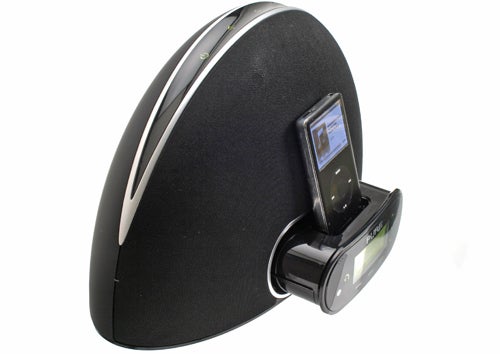
Verdict
Pros
- Stylish design
- Compact and well made
- Feature packed
- Intuitive controls
- Plenty of volume
Cons
- Sluggish operation
- Muffled high-end to audio
- Disjointed bass
- Narrow sound
Key Specifications
- Review Price: £189.95
- Slideout iPod dock
- DAB, FM and Internet radio
- Remote control
- 38w RMS audio output
The Contour’s shape is that of the now familiar squashed hemisphere, as sported by the Pure Twilight and the Meridian F80, amongst others. It’s a style we rather like and Pure seems to have done a good job with this particular example. The matt, soft-touch back, cloth covered front and glossy strip running down the middle combine well to create a classy looking whole. The control cluster on the front, despite having yellow backlighting also keeps things looking neat and tidy.
Push said controls into the body of the radio and the whole lot slides out to reveal an iPod dock, compatible with the standard array of inserts for fitting the full range of Apple products. A selection of black inserts is included in the box, but they all appear to be for previous generation iPods and iPhones, so you’ll need to shop around to find a way of holding your iPhone 4 (yes it is compatible) securely. You may not be too surprised to hear, though no less miffed, that it can’t accommodate an iPad. 
The slide mechanism does require a bit more force than we’d ideally want, and doesn’t have the smoothest action going, but it seems fairly secure. A large oval of rubber on the underside of the radio keeps the whole device securely held, though as ever if it gets dusty you may find it relinquishes its grip, resulting in you having to keep one hand on the back of the radio as you push in the dock, or risk sliding the whole thing of your bedside cabinet.
On the subject of furniture, the Contour is quite large, with a footprint of 37 x 16.5cm and a height of 21cm, so it may not fit on some smaller bedside drawers/tables. Then again, precisely because of this, this should perhaps be considered a more universal round-the-house radio for use in the living room and such like. 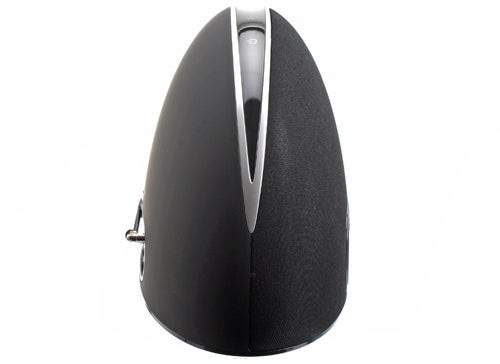
Overall build quality seems decent with solid feeling plastics used throughout, and the whole unit has a reassuring weight to it (2.9Kg). However, it’s certainly not perfect. The silver strip across the top, in particular, has a few dodgy edges, where you can see the seams from the mould the plastic was formed in. You’re not going to notice at a distance but it’s still a little disappointing when we have high expectations from Pure.
Round the back of the device you’ll find a sturdy and long telescopic aerial that did a reasonable job of finding stations at our office, where we have a very poor signal. There are also jacks for Headphone and Aux In along with Composite and S-Video outputs for piping video from your iPod to a TV (we really don’t know why audio companies put these on these compact iPod docks – it’s not a value add, no-one ever uses them!). 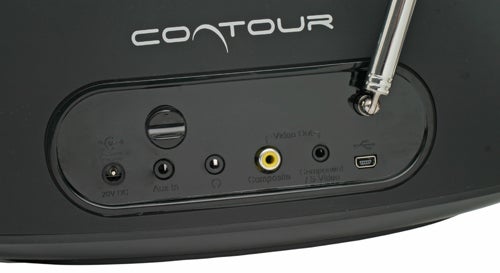
Internally you’ll also find Wi-Fi for hooking the Contour up to your Internet connection, whereby you’ll be able to access Internet radio stations as well as the Pure Lounge. The latter links in with an online portal for you to easily manage what online radio stations you want to listen to. If you’re without Wi-Fi and require Ethernet you can buy the optional miniUSB to Ethernet adapter for just that purpose. All three of these connections can also be used to update the device with its latest firmware.
Getting back to the main control cluster, you have a half a dozen or so buttons for controlling the main interface, with Home on the left, three buttons underneath the screen that change role depending on what the screen is showing, plus Up and Down arrows, Select and Back on the right. Joining these are Power, Volume Up, Volume Down, and Mute buttons nestled in the strip that runs over the top of the device. All are touch sensitive, which means you loose the tactile appeal of proper buttons, making it more difficult to grope around in the dark. However, they are all backlit, so as long as you can see them, they’re easy enough to operate. What’s more, Pure’s signature touch of being able to simply tap the top of the radio to snooze any alarms is on hand, which is always welcome.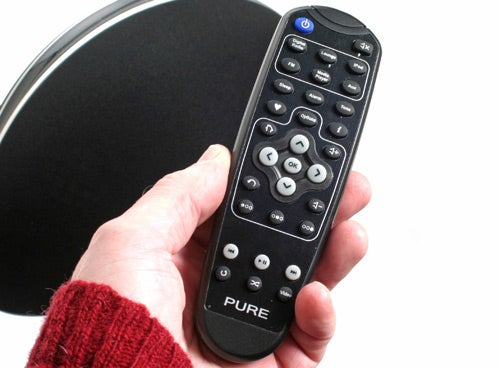
You also get a remote, which is a fairly generic looking lump of black plastic. However, it feels reasonably solid and comfortable in the hand, and takes standard AAA batteries rather than the button cells of some alternatives. The buttons aren’t backlit and are rather drab looking but do have a generally intuitive layout and an action that lets you’re know when you’ve pressed them. We’re not too sure how long the graphics on the buttons will last with prolonged use, though.
Overall, the control system doesn’t quite feel as nice as we’d hope. Most previous Pure’s we’ve encountered standout precisely because they’re so easy to use whereas this model is rather sluggish. For example, when moving through menus you regularly scroll right past the selection you wanted because you’ve pressed the up or down buttons too many times while waiting for the display to update. Also switching between inputs takes between two and three seconds while powering the unit on takes the best part of 10 seconds. 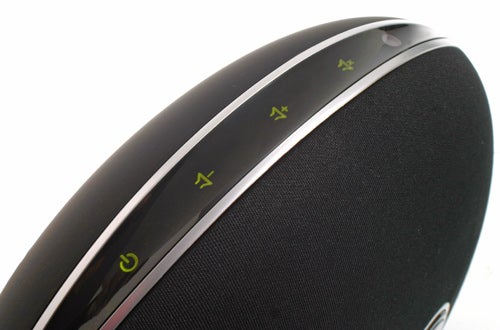
The display itself isn’t the best, either. Rather than the OLED panels we’re used to seeing on Pure devices it uses an LCD which is much more perceptible to having poor viewing angles. And indeed we found in the crucial test of checking the time from the comfort of our bed that it failed miserably, with no numbers clearly discernible. This isn’t to say the whole thing’s a disaster, just that you’ll have to sit up in bed to check the time.
We started our general usability and audio testing with the iPod dock, popping an iPhone 4 into it and having a flick through a few of our favourite tracks. One of the first things we noticed was that opening the tray didn’t automatically turn the radio on and change it to iPod mode, which one might’ve expected. The controls work well with a conventional iPod but don’t hold up quite so well with iPhones and iPod Touchs, though you can get by.
In terms of audio quality, the Contour delivered a rather schizophrenic performance. One minute it seemed pleasant enough with a fairly hefty dose of bass and a generally pleasing mid to top range, then other times it really fell flat.
The overarching characteristics are of it producing a very narrow sound that simply never creates an absorbing stereo effect, having a slightly muffled top end, and it having a very separate bass sound. With music that has a fairly flat mix or that uses few localised instruments, this isn’t too much of a problem, but if you’re listening to some orchestral music, or just some well mixed multi layered pop music, it just sounds so flat yet disjointed. What’s more, sometimes (Blur’s Country House springs to mind) the vocal parts just jump out the mix and sound like they’re coming from two feet in front of the rest of the music, and not in a good way. 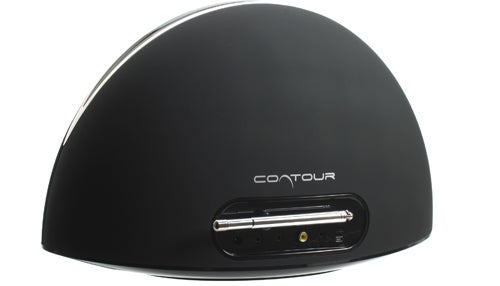
The separate bass is best demonstrated by Adam Freeland’s Fabriclive.16 album where the opening gently swells into life before kicking in with the full bass drum line after a couple of minutes. On the Contour, the opening is slightly muffled and distant, and lacking in warmth then suddenly the bass kicks you in the nethers. Conversely, listening to both some Eric Clapton, from his The Blues album, and some solo harpsichord Scarlatti sonatas produced a nice, easy to listen to performance.
All told, while this is certainly a cut above smaller bedside radios in terms of sheer power – the top volume means this could certainly serve as the beat provider for your bopping – there’s little to set it apart in terms of refinement. Though we’re well aware that cheap mini Hi-Fi systems can be just as ropey, we can’t help but think such a device would deliver a more rounded performance.
Moving onto DAB, we found it easy to tune and flick through stations, while setup and recalling of our favourite stations was also a breeze, with up to 30 presets available (for both DAB and FM). There are no dedicated buttons for recalling your absolute favourites in one fell swoop but a couple of intuitive button presses should get you there. Sound quality benefits from the less than clinically accurate audio the unit produces in general, with many artefacts from a poor quality signal or low bitrate masked. It’s much the same with FM, which can easily be tuned either manually or by seek tuning to the next station. 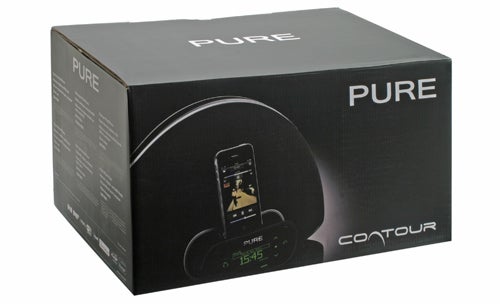
Jumping into the Lounge, you can access Internet radio, searching for what you want using an onscreen keyboard, and adding your favourites to, well, your favourites (of which you can have many). Podcasts can also be accessed, along with listen again services, and Pure Sounds. The latter gets you access to a whole host of sounds from whale calls to pneumatic drills. It’s quite a powerful service that, when combined with the online portal, is surprisingly easy to manage.
Costing around £200, the Pure Contour is okay value but can arguably come into competition with many different products. You could opt for a a higher quality though smaller and less well featured radio like the Vita Audio R1 (or indeed it’s larger sibling the R2, if you willing to fork out an extra £50). A mini HiFi such as the Onkyo dr645 offers an iPod dock and conventional FM radio, as well as old school CD playback, and produces much more pleasing audio. Or, you could simply get the proper bedside equivalent of this radio, the Pure Evoke Flow – it lacks the audio power but is easier to use.
”’Verdict”’
The Pure Contour is a great audio all-rounder with it delivering DAB, FM, iPod, and Internet radio in one compact unit that looks tidy, includes a remote and can fill a room with sound. However, it’s let down by sluggish operation, a mediocre screen, and most importantly of all audio quality that just never quite satisfies.
Trusted Score
Score in detail
-
Value 7
-
Features 8
-
Usability 7
-
Design 9

